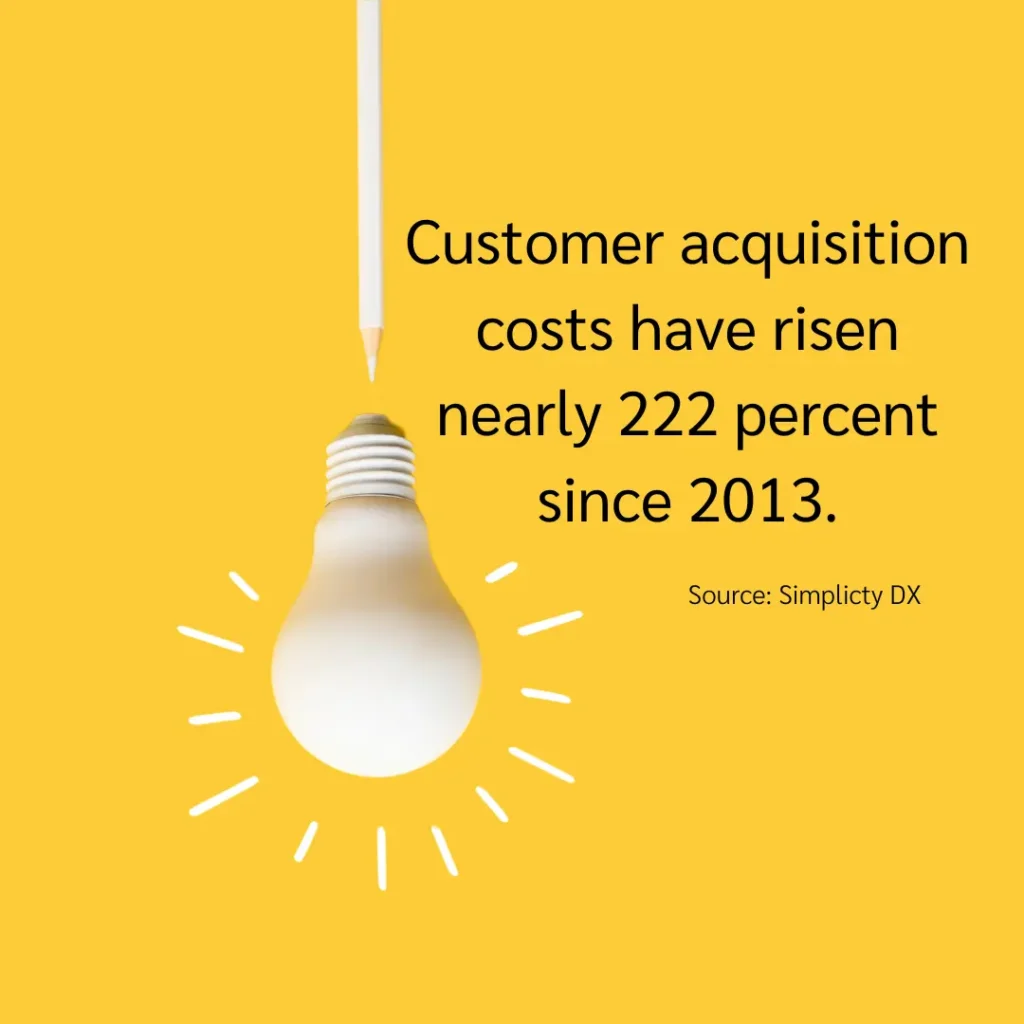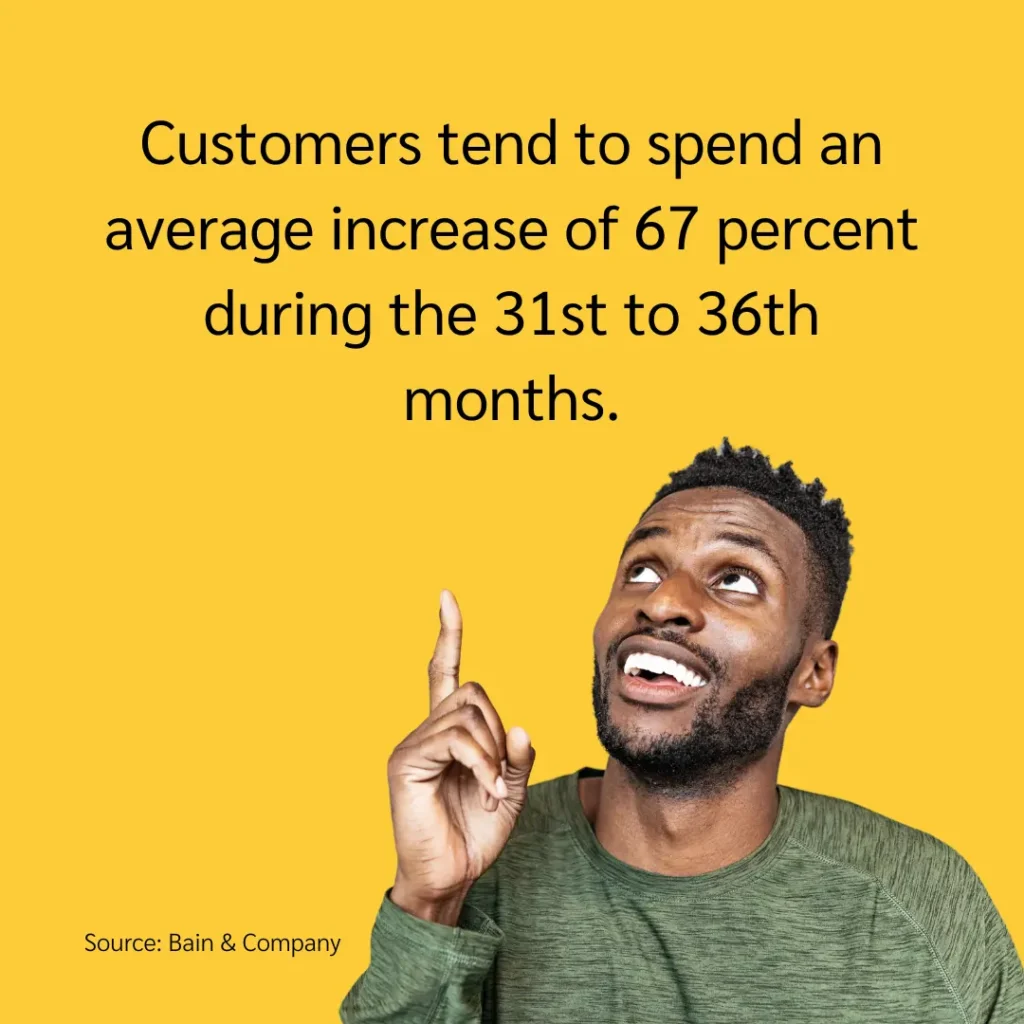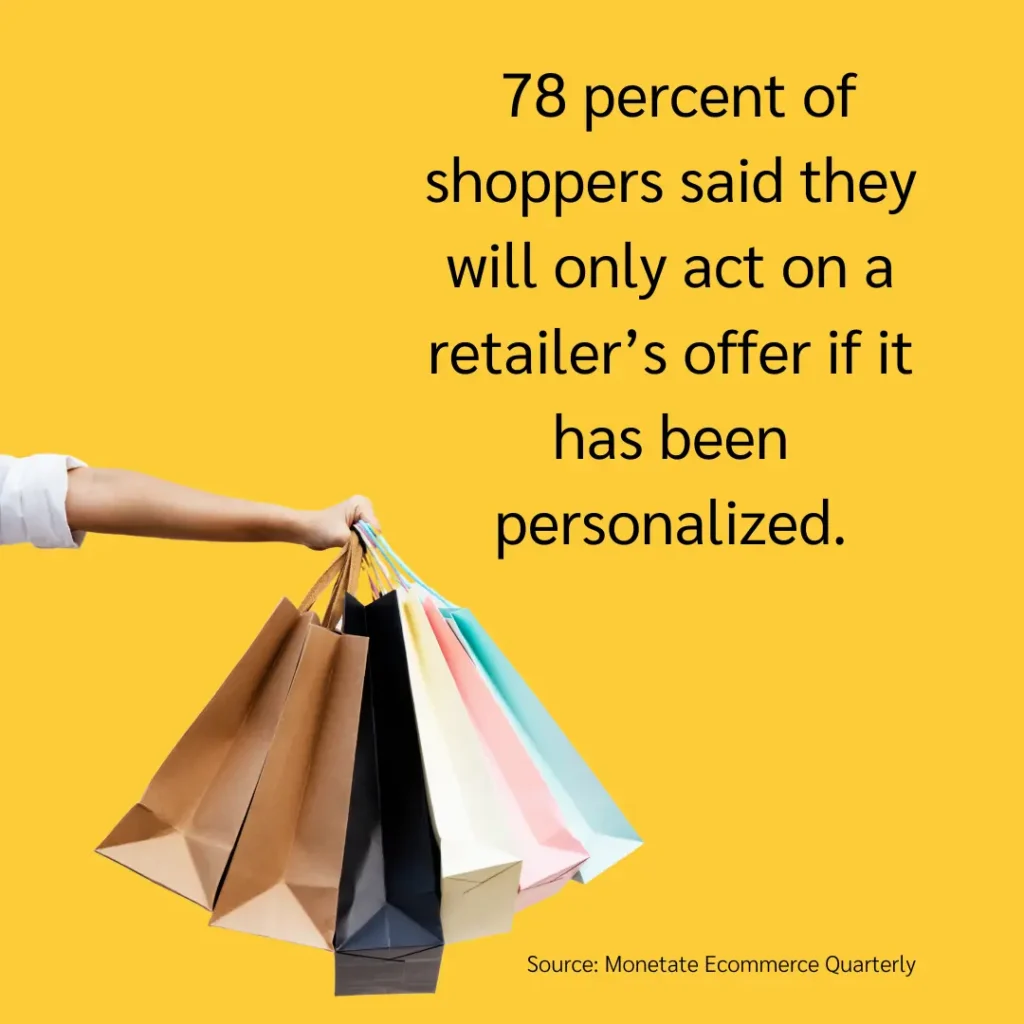Starbucks Rewards is emblematic of the coffee chain’s brand. The company built it’s customer loyalty program based on a tiered points system, where frequent visitors can earn points that add up to free products.
Rewards programs are one of many retention marketing strategies— or engaging with and retaining existing customers— that brands can use to encourage repeat business.
In 2024, retention marketing will become increasingly important as companies strive to balance customer retention with acquisition. Research has shown that even a five percent increase in customer retention may enhance profits by up to 75 percent.
Brands should find ways to stand out in a crowded market and keep their current customers returning for more. This means implementing effective retention strategies that maintain customer loyalty and attract new ones through positive word-of-mouth referrals from satisfied customers.
An overview of retention marketing
Retention marketing is a form of marketing that aims to maximize the value of your current customers. It engages with them beyond their initial purchase and makes them loyal, long-term, and repeat purchasers.
Customer retention strategies are essential because returning customers spend more than new ones. Research has shown that acquiring new customers can cost up to five times more than keeping existing ones. That’s why businesses need to invest in retention tactics actively.
It’s different from traditional “acquisition-focused” marketing because the primary goal is not to get more customers.
Retention vs. acquisition: what’s the difference
Retention and acquisition marketing represent two fundamental strategies with distinct focuses and objectives within the broader business growth and sustainability framework.
Acquisition marketing focuses on attracting new customers to your business. It’s the initial step in the customer life cycle, where the primary goal is to expand your customer base through various channels such as social media advertising, pay-per-click campaigns, content marketing, and SEO strategies.
The key objectives here are visibility and engagement, allowing your brand to reach potential customers who have yet to be made aware of your brand or engage with it.
On the other hand, retention marketing targets keeping existing customers engaged, satisfied, and loyal. This strategy emphasizes creating value beyond the initial purchase by enhancing the customer experience, offering personalized communication, loyalty programs, and targeted offers based on previous purchasing behavior and preferences.
Retention marketing recognizes that existing customers are more likely to make repeated purchases, often at a higher average order value—and can become advocates for your brand, referring new customers through word of mouth.
Focusing on a balanced approach that leverages the strengths of acquisition and retention marketing will enable businesses to attract and maintain a loyal customer base, driving long-term success and profitability.
The goals of a retention marketing strategy
The main goal of retention marketing is to encourage repeat purchases and increase product usage from existing customers.
- For an e-commerce or on-demand product, this means encouraging customers to return to your website or app to make repeat, higher-value purchases.
- For a subscription service, this means encouraging a user to keep their subscription active or have them upgrade to a more advanced plan.
Your brand can aim retention marketing strategies at current, active customers or churned customers requiring re-activation.
Why customer retention marketing is vital to your business
You can prioritize customer satisfaction by focusing on retaining your current clientele. Implementing successful retention tactics, including delivering excellent customer service, maintaining regular engagement, and offering incentives to loyal, longstanding customers, can greatly contribute to this goal.
According to research by Simplicity DX, customer acquisition costs have risen nearly 222 percent since 2013, and it’s still climbing.

Here’s why this is important to understand:
Let’s say your cost to acquire a new customer is $500, but they churn after paying your business only $200 in revenue. Because you don’t have any customer retention strategies, you won’t see a positive ROI on the money you spend to acquire them.
In an interview with AdNews, Adobe CEO Shantanu Narayen said that too many companies are chasing customer acquisition when the real value lies in driving product usage and understanding what high-value actions customers take.
5 ways retention marketing increases CLTV
Customer lifetime value (CLV) estimates the total revenue a business can expect from a single customer account throughout their relationship with the company. It’s a crucial measure that helps businesses understand the long-term value of investing in customer relationships rather than focusing solely on short-term transactions.
At its core, CLTV provides insight into the profitability of maintaining long-term relationships with customers. It considers the initial purchase and the expected future purchases a customer will make. This approach shifts the focus from transactional interactions to fostering loyalty and continuous engagement.
Retention marketing is pivotal in increasing CLTV by implementing strategies designed to keep customers engaged and satisfied over time. These are five ways retention increases CLTV.
Customer retention is cheaper and easier
The average customer acquisition cost (CAC) across ten different industries was calculated at $606, demonstrating that the challenge of rising CAC is not confined to a single sector but is a widespread issue affecting businesses globally.
This trend towards higher acquisition costs emphasizes the importance of leveraging efficient retention strategies. The impact of customer retention extends beyond immediate financial gains.
Money spent on retention is more effective than money spent on acquisition
When it comes to budgeting for marketing, many businesses prioritize customer acquisition. After all, getting new customers through the door is incredibly important for long-term growth and profitability. However, research has shown that spending money on customer retention can be even more effective than spending on acquisition—and often at a much lower cost.
Retained customers are more likely to make repeat purchases and can become brand advocates, indirectly contributing to new customer acquisition at no additional cost. The referrals from satisfied customers testify to the quality and value of the product or service, further enhancing the brand’s reputation and appeal to potential customers.
Retention boosts profits
Combined with the fact that existing customers are cheaper to retain and easier to sell to, a 5 percent increase in customer retention can boost revenue by 25-95 percent.
An engaged customer spends 67 percent more in months 31-36 of their relationship with a business than in months zero through six, highlighting the importance of efforts to keep the relationship active.
In e-commerce alone, a customer who has made multiple purchases is worth five times as much as a first-time visitor.

Retention fuels acquisition
While the main goal of retention marketing isn’t to bring in new customers, it’s a proven byproduct.
When you try to retain satisfied customers, they become your best acquisition strategy through word-of-mouth marketing and referrals, which 92 percent of consumers trust more than any other form of advertising.
The more customers return to do business with you, the more likely they are to give a referral. The average first-time shopper will refer three people to the site. After ten purchases, that shopper will have referred seven people.
Customer retention combats the increasing potential for churn
Customer retention strategies directly address churn by creating a strong, positive relationship between a business and its customers, encouraging ongoing engagement and loyalty. These strategies focus on ensuring customer satisfaction, understanding and meeting customer needs, and providing value beyond the initial purchase. Businesses can significantly reduce the likelihood of customers leaving for a competitor by doing so.
For instance, implementing personalized communication, rewards programs, and regular feedback channels can make customers feel valued and understood. This personal touch enhances the customer experience and builds emotional ties, making customers less likely to churn.
Retention marketing strategies
Through targeted approaches and innovative tactics, your company can effectively engage, satisfy, and retain their customer base. From personalized communication and loyalty programs to leveraging data analytics for tailored experiences, these strategies aim to reduce churn rates and amplify customer lifetime value, ultimately securing a competitive edge in today’s fast-paced market environment.
Launch a loyalty program
A loyalty program can be an effective tool for improving customer retention. Loyalty programs reward customers for their repeated purchases, encouraging them to come back again and again. They’re also a great way to show appreciation for loyal customers and increase brand awareness.
By offering valuable incentives, you give customers a reason to return and continue spending with you. When customers rack up points they can only use with your brand, they’ll be less inclined to switch to competitors to avoid losing their progress.
Loyalty rewards also demonstrate that you value a customer’s willingness to do business with your brand. This can significantly reduce churn: 68 percent of customers leave if they think you’re indifferent to them.
The most effective programs for retention are:
Win Back Program: Send a special offer to customers who haven’t purchased or logged in after a certain amount of time.
For example, offer one free month to users who cancel their subscription and haven’t reactivated it in three months.
VIP Program: Offer exclusive rewards to your most loyal customers. When more spending equals better rewards, engagement with your brand turns into a habit.
For example, offer a free set of company swag to customers who spend $100 in one month.
Deliver increased personalization
A reported 78 percent of shoppers said they will only act on a retailer’s offer if it has been personalized to their previous actions with the brand.
Think about it—if you had a “friend” who never remembered your birthday, favorite hobby, or dog’s name, it would become pretty frustrating to hang out with them as it doesn’t feel like they’re willing to pay attention to you.
On the flip side, if you spend time with a friend who asks relevant questions about your interests and goals that show they’ve been listening to you, you’ll be more inclined to maintain the relationship because you feel appreciated.
Personalization is effective for improving customer retention strategies. By offering personalized products and experiences, businesses can show appreciation for their patronage and build loyalty to the brand. Personalization can take many forms, from customized product offerings tailored to individual needs to unique customer service experiences.
Retaining customers with increased personalization can be as simple as recording each user’s birthdays or anniversaries with your brand and sending them a special note or incentive to celebrate.

Highlight customer progress
The psychology of loyalty programs is that individuals tend to exert more effort towards achieving a goal as they near its attainment.
Whether it be how much money they’ve saved since becoming a client, or how many pounds they’ve lost since using your app, remind customers of the positive progress they’ve made with your brand to encourage more usage.
Leverage progress emails, push notifications, or a dedicated activity hub in your app to showcase customer progress and help them set new goals.
Plus, this kind of recognition presents the perfect “happy moment” to promote new offerings or encourage an upgrade, as the customer is acutely aware of the value they derive from your product.
Create a customer advisory council
A customer advisory council is a select group of customers that you meet with to discuss product improvements, share roadmap plans, and set company priorities.
Ultimately, it’s a way to understand what customers expect from your brand and identify any pain points contributing to churn.
By giving your customers a dedicated feedback channel, your business receives important insights, and your customers feel like their opinions are valued. When customers feel involved in shaping the future of your business, they’ll be more dedicated to supporting you.
FAQ
The retention stage of marketing is a critical phase where businesses focus on keeping their existing customers engaged and satisfied over the long term. At this juncture, the key objective is to nurture ongoing relationships, ensuring that customers continue to find value in the products or services offered. This involves implementing strategies designed to enhance customer loyalty, encourage repeat business, and increase the likelihood of referrals to new potential customers.
Here are some effective examples of retention marketing strategies:
-
- Personalized email campaigns: Tailoring emails to meet customers’ specific interests and needs can significantly boost engagement rates.
-
- Loyalty programs: Designing a rewards system for repeat purchases or actions encourages ongoing engagement.
Customer feedback and surveys: Actively seeking and responding to customer feedback shows a commitment to meeting their needs and expectations.
- Loyalty programs: Designing a rewards system for repeat purchases or actions encourages ongoing engagement.
-
- Educational content: Offering your customers useful information, how-tos, and resources related to your products or services adds value beyond the transaction.
-
- Exclusive events or access: Inviting loyal customers to exclusive events or giving them early access to sales or new products makes them feel part of a special community.
Foster meaningful relationships by starting your customer retention program
Retention strategies are no longer a nice-to-have for digital businesses. Without the ability to engage and retain your best customers, you won’t be able to realize a profit. While retention marketing doesn’t wholly replace acquisition marketing, it’s a necessary part of your growth strategy.
It provides the opportunity to foster meaningful relationships with valuable customers, build long-term loyalty and drive repeat purchases and referrals. It also encourages more deeply engaged engagement with your products and services, generating higher purchase frequency, larger order values, improved customer experience, and ultimately increased revenue.
Connect with a customer retention expert to learn more about building your strategy. Request a demo.




